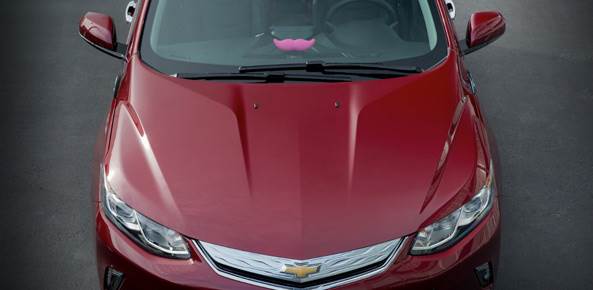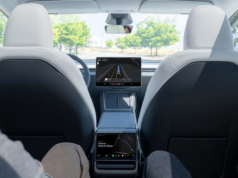
Lyft — trying to keep up with its longtime ride-hailing competitor Uber, which just rolled out a self-driving pilot in Pittsburgh — is being more explicit about what company president John Zimmer has dubbed the “third transportation revolution.”
Zimmer laid out that plan in a Medium post published today, titled “The Third Transportation Revolution: Lyft’s Vision for the Next Ten Years and Beyond.”
In the post, he described efforts to roll out self-driving cars in three phases, the first of which will likely be available by 2017. In that phase, semi-autonomous cars will be made available to Lyft users, but will only drive along fixed routes that the technology is guaranteed to be able to navigate.
This plan comes after nearly a year after Lyft began its foray into the future of transportation in January 2016 — General Motors invested $500 million in the company in exchange for a 10 percent stake and an agreement to build a network of self-driving cars together.
In the second phase, the self-driving cars in the fleet will navigate more than just the fixed routes, but will only drive up to 25 miles per hour. As the technology matures and the software encounters more complex environments, Zimmer wrote, cars will get faster.
The third phase, which according to the graph the company expects to be sometime in 2021 or 2022, will be when all Lyft rides will be completed by a fully autonomous car. Shortly after that phase begins, car ownership will see a steep dropoff, according to Zimmer. Zimmer, who has long been a vocal proponent of ending car ownership, set a date for the death of the personally owned car in major U.S. cities: 2025.
Zimmer’s argument in short: People won’t own cars, they’ll just use Lyft.
While Zimmer is setting these lofty goals, it’s still unclear whether GM is fully sold on that idea. In the past, the company’s CEO Mary Barra has said she agrees that personal car ownership may decrease as shared networks become rampant in the near term, but expects it to return to its heyday sometime down the road.
“We realized that autonomous technology will first be introduced in a shared model,” GM CEO Mary Barra told me shortly after the company invested in Lyft. “But there will be a point where there will be an individual owner as well; that’s why we’re working on both.”
Ironically, Barra’s mindset at the beginning of 2016 was recently echoed by Tesla founder and CEO Elon Musk, whom many see as GM’s biggest competitor. In the second part of Musk’s “master plan,” he wrote about a future where Tesla would operate a shared network in which owners could opt into letting strangers use their self-driving cars in exchange for money.
It’s a recent development for Musk, who initially wasn’t convinced that car-sharing or ride-sharing was the way of the future, according to several sources. And, while Zimmer gives Musk credit for seeing the importance of a shared network of cars, he vehemently disputes Musk’s vision for the future.
“For starters, our fleet will provide significantly more consistency and availability than a patchwork of privately owned cars,” he wrote. “That kind of program will have a hard time scaling because individual car owners won’t want to rent their cars to strangers. And most importantly, passengers expect clean and well-maintained vehicles, which can be best achieved through Lyft’s fleet operations. Today, our business is dependent on being experts at maximizing utilization and managing peak hours, which allow us to provide the most affordable rides.”
(I made a similar argument when Musk published the second part of his master plan.)
In the meantime, in the time people still own cars, Lyft expects to operate a hybrid model where both robot cars and human drivers perform rides on the platform for the next five to 10 years.
In fact, he argues that in the next five years, there actually may be more of a demand for Lyft drivers, not less. His logic is simple: Once Lyft has self-driving cars the cost of a ride will likely decrease, which will create an increase in demand and more people using Lyft.
“When autonomous cars can only solve a portion of those trips, more Lyft drivers will be needed to provide service to the growing market of former car owners,” Zimmer wrote.
It’s a strategy that really drives home the idea that drivers are mere stopgaps in Lyft (and Uber’s) long term plans, but it’s not unfounded. It’s a model that has worked for Lyft before — when the company subsidizes its rides and only charges $5 to $10 a pop demand increases and the company has a pretty good idea of just how much demand will jump.
Incidentally, Lyft’s self-driving network won’t work exactly the way hailing a Lyft works today. Instead, Lyft is going the way of Netflix and Amazon Prime and will roll out monthly subscription packages. So, you’ll be able to choose between a pay-as-you-go plan where you pay a few cents per mile or buy a certain amount of miles for the month.
In that way, transportation becomes more of a utility.
It’s certainly clear that Zimmer’s piece is timed with the launch of a number of competing self-driving pilots, from Uber’s to nuTonomy’s, but it also reads a lot like an urgent plea to regulators to begin thinking about how self-driving technology will impact the way cities operate.
“Most of us have grown up in cities built around the automobile, but imagine for a minute, what our world could look like if we found a way to take most of these cars off the road. It would be a world with less traffic and less pollution. A world where we need less parking – where streets can be narrowed and sidewalks widened. It’s a world where we can construct new housing and small businesses on parking lots across the country — or turn them into green spaces and parks,” wrote Zimmer. “That’s a world built around people, not cars.”
Cities, originally designed around cars, will suddenly be able to reclaim much of the space otherwise occupied by things like garages, parking lots and gas stations. But it’s not enough to simply imagine what a city with more space for parks and pedestrians might look like, Zimmer argued, it’s time to start planning.
“The design of our cities has tremendous implications on global economics, health, social equality, the environment, and overall quality of life,” he wrote. “The problem is, not nearly enough time is spent considering how we can improve our collective home.”
He continued: “Our society is at a fork in the road and whether we take the right path is not inevitable. I don’t have all the answers, but what I do know is that decisive action must be taken by all of us – business leaders, policymakers, city planners, and citizens – to realize the full potential of this almost unprecedented moment in history.”
With all this big thinking about autonomous cars, it’s important to remember: A decade ago, self-driving cars were a matter of debate; today, it’s an inevitability.
© 2016 Re/Code under contract with NewsEdge. -.







